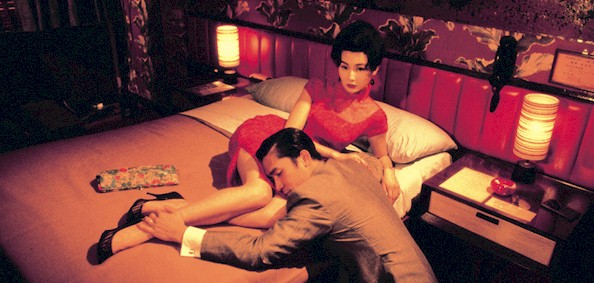The Aesthetic Cinema of Wong Kar-Wai
 |
| Tony Leung and Maggie Chung in In the Mood for Love (Wong Kar-Wai, 2001) |
 |
| Wong Kar-Wai |
 |
| Tony Leung in the sumptuous In the Mood for Love |
The first thing that strikes you about Wong Kar-Wai is that he clearly knows how to pose for a photograph (this, of course, is a bowel-shatteringly hilarious reference to my own profile picture **UPDATE I've changed my picture now so this doesn't make sense, but it wasn't funny anyway**). He has style and is ineffably cool (clearly where references to any similarity between him and I come crashing to a halt) and this invariably translates to his films. Often emanating from his long standing leading man of choice, the equally cool Tony Leung, or the elegant cool of long standing leading lady Maggie Chung, and the glorious images captured by his long standing cinematographer of choice, the, perhaps less obviously, cool Christopher Doyle. Style pours from his films like cool water from a really chic tap into a stylish sink, forming an utterly sophisticated pool.
Images are important in Wong Kar-Wai's movies, images provide everything for us. The delivery of plot development, mood and character background are not absent or unimportant, they are just delivered differently or are perhaps beautifully coded into the images, and so may seem secondary in a cursory viewing. This is perhaps held over from his training as a graphic designer, but it is purely cinematic, even the cramped, confined spaces of In the Mood for Love or Chungking Express (1994) seem almost grand and deceptively epic in scale and are utterly important to the telling of these character's stories in each of these places at these various times.
 |
| Ashes of Time |
The films of Wong Kar-Wai don't necessarily follow an obviously prescribed narrative form and don't seem to feel the need to explain everything to the audience (as I tried to clumsily suggest above). He rarely uses an establishing shot and sometimes anchors his audience in unusual ways - like through time and distance rather than geographically accurate place naming as in My Blueberry Nights (2007) or recurrent musical themes like 'California Dreamin'' by The Mamas and the Papas in Chungking Express. These elements give the films a sense of structure, that at the same time feels free and full of coincidence. This can be distancing at times but the characters are often involved in some search for identity and this idea of corporal or emotional distance is arguably an important theme, as is time and space, and while the characters struggle with their problems and insecurities so too do the audience.
 |
| Happy Together |
 |
| In the Mood for Love |
Repetition abounds in his films, whether it is repetition across his own films In The Mood for Love and Happy Together (1997) (See stills), or within a single film through a strong use of visual and aural motifs, again In the Mood for Love or Chungking Express fit well here. He is also prone to repetition of others work through intertextual references, like the Top Gun (Tony Scott, 1986) finale in As Tears Go By (1988) but this is not done in a simple Tarantino-esque (I just died a little inside after writing that), self satisfied way; it is more pastiche than parody. 'Although he draws on many and disparate sources in his films, he is never a postmodernist bricoleur. His work deals with primary emotions, not secondary echoes of emotions; he cares about feelings, not cultural gestures.' (Sight and Sound, 2000)
Genre doesn't seem to be able to suitably coral his style. He has ranged across period and contemporary romance (In the Mood for Love or Happy Together), Sci-Fi (2046, 2004), Wuxia (Ashes of Time, 1997) and Crime (Fallen Angels, 1995). The worlds are oddly familiar but skewed, the characters may look like their trope but often behave unconventionally or react just plain weird, and all the recurrent elements you can usually knowingly point to, toss your head back a bit and go, "Oh yeah, saw that coming", often don't seem to arrive.
His films come together only as a combination of all of these things, in isolation they may be arresting, beautiful and intriguing but they may also perhaps come off as little more than tantalising and frustratingly promising. As Elizabeth Wright notes: 'His focus on detail over totality consolidates his talent for creating a distinct mood and atmosphere, a visual pastiche of colours and emotions.' (Senses of Cinema, 2002) He seems to me to be a fairly effortless filmmaker, not to diminish the amount of work or prep he puts in - natural is probably a better way to put it - but his films are frequently beautiful, thought provoking, challenging, innovative, as I think all good filmmaking should (for whatever that's worth). Roll on his long gestating, perhaps scrapped, remake of The Lady from Shanghai (1947) originally directed by, another seemingly effortless but detail driven filmmaker, Orson Welles.
I don't love all his films and there is still only one on the list, but I won't miss one and I implore you to watch at least one, even if it's only to tell me "Pffft!" Thanks for your time, J
Wong Kar-Wai Filmography

I had to watch 'Happy Together' for one of my modules last semester and I thoroughly enjoyed it. The colour pallet, framing and editing were fantastic.
ReplyDelete